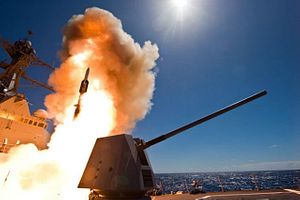Days after North Korea launched an intermediate-range ballistic missile that flew over Japan’s northern island of Hokkaido and landed in the northern Pacific Ocean, the U.S. Navy successfully conducted a complex missile defense test this week at the Pacific Missile Range Facility off Kauai, Hawaii, according to a Raytheon company statement.
The Standard Missile-6, one of the U.S. Navy’s most advanced missile interceptors, intercepted a medium-range ballistic missile target at sea in its final seconds of flight, after being fired from the Arleigh Burke-class guided missile destroyer USS John Paul Jones. “John Paul Jones detected and tracked a target missile launched from the Pacific Missile Range Facility on Kauai, Hawaii with its onboard AN/SPY-1 radar, and onboard SM-6 missiles executed the intercept,” an August 30 U.S. Missile Defense Agency (MDA) statement reads.
The endo-atmospheric interceptor uses a blast-fragmentation warhead to engage its target.
The principal objective of the launch was test to a new targeting software designed to enable the SM-6 to intercept a ballistic missile warhead descending from the upper atmosphere at extreme speed. “Earlier this year, our customer requested an enhanced capability to deal with a sophisticated medium-range ballistic missile threat,” Raytheon’s Standard Missile-6 senior program director said in the August 30 statement. “We did all this – the analysis, coding and testing – in seven months; a process that normally takes one to two years.”
The sense of urgency can partially be traced back due to rising tensions on the Korean Peninsula as North Korea’s is rapidly advancing its burgeoning ballistic missile program. Among other things, Pyongyang has repeatedly flight-tested its solid fuel, medium-range Pukkuksong-2 ballistic missile this year. It purportedly has also been working on a submarine-launched variant of the missile, the Pukkuksong-3. However, the August 30 test had been planned for a long time and before North Korea’s latest missile launch.
“We are working closely with the fleet to develop this important new capability, and this was a key milestone in giving our Aegis BMD [ballistic missile defense] ships an enhanced capability to defeat ballistic missiles in their terminal phase,” MDA Director Lieutenant General Sam Greaves said in a statement. “We will continue developing ballistic missile defense technologies to stay ahead of the threat as it evolves.”
Vertically-launched from a a MK 41 VLS canister, the Mach 3.5+ Standard Missile-6 originally has been designed for anti-air warfare, anti-surface warfare missions, but has been modified in 2015 for sea-based terminal ballistic missile defense (dubbed Standard Missile-6 Dual 1) supplementing the U.S. Navy’s Standard Missile-3 ballistic missile interceptor deployed at land-based Aegis Ashore sites and Aegis-equipped warships.
The August 30 test launch was the third time that the Standard Missile-6 successfully engaged a ballistic missile target in its terminal phase. The U.S. Navy test-launched a Standard-Missile-6 missile in July 2015 for the first time, successfully intercepting and destroying a short-range ballistic missile target at sea in its terminal phase. The missile was again tested in December 2016, successfully destroying a medium-range ballistic missile target at sea.
The Standard-Missile 6 operates as part of the Aegis combat system, a highly advanced automated command-and-control and weapons control system built around a sophisticated multi-function radar system, and capable of tracking up to 100 missiles simultaneously. The Aegis Baseline 9.C2 weapon system has been specifically designed for ballistic missile defense, and along with an earlier version, Baseline 9.C1, can engage in simultaneous air and ballistic missile defense.
In order for the Standard Missile-6 to intercept a North Korean ballistic missile, the Aegis combat system would have to start tracking the missile in its ascent phase and launch interceptors before it overflies the warship. The United States has also been working closely with the Republic of Korea Navy and the Japan Maritime Self-Defense Force to facilitate timely acquisition and sharing of North Korean ballistic missile data among the three navies to enhance the chances of a successful interception.































